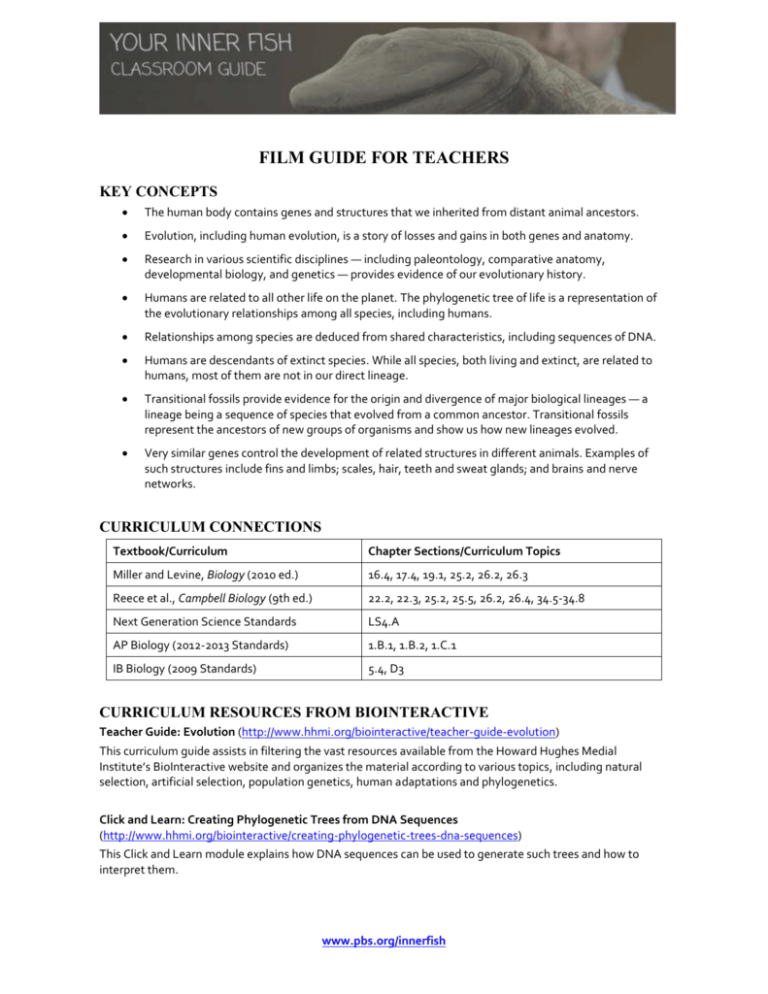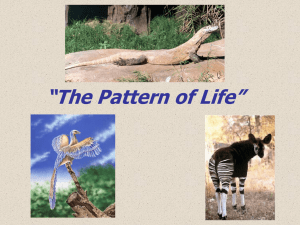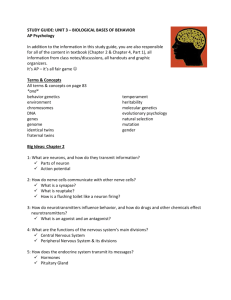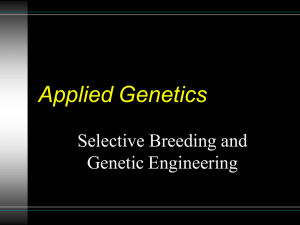Poster: Fossil Evidence and Evolution
advertisement

FILM GUIDE FOR TEACHERS KEY CONCEPTS The human body contains genes and structures that we inherited from distant animal ancestors. Evolution, including human evolution, is a story of losses and gains in both genes and anatomy. Research in various scientific disciplines — including paleontology, comparative anatomy, developmental biology, and genetics — provides evidence of our evolutionary history. Humans are related to all other life on the planet. The phylogenetic tree of life is a representation of the evolutionary relationships among all species, including humans. Relationships among species are deduced from shared characteristics, including sequences of DNA. Humans are descendants of extinct species. While all species, both living and extinct, are related to humans, most of them are not in our direct lineage. Transitional fossils provide evidence for the origin and divergence of major biological lineages — a lineage being a sequence of species that evolved from a common ancestor. Transitional fossils represent the ancestors of new groups of organisms and show us how new lineages evolved. Very similar genes control the development of related structures in different animals. Examples of such structures include fins and limbs; scales, hair, teeth and sweat glands; and brains and nerve networks. CURRICULUM CONNECTIONS Textbook/Curriculum Chapter Sections/Curriculum Topics Miller and Levine, Biology (2010 ed.) 16.4, 17.4, 19.1, 25.2, 26.2, 26.3 Reece et al., Campbell Biology (9th ed.) 22.2, 22.3, 25.2, 25.5, 26.2, 26.4, 34.5-34.8 Next Generation Science Standards LS4.A AP Biology (2012-2013 Standards) 1.B.1, 1.B.2, 1.C.1 IB Biology (2009 Standards) 5.4, D3 CURRICULUM RESOURCES FROM BIOINTERACTIVE Teacher Guide: Evolution (http://www.hhmi.org/biointeractive/teacher-guide-evolution) This curriculum guide assists in filtering the vast resources available from the Howard Hughes Medial Institute’s BioInteractive website and organizes the material according to various topics, including natural selection, artificial selection, population genetics, human adaptations and phylogenetics. Click and Learn: Creating Phylogenetic Trees from DNA Sequences (http://www.hhmi.org/biointeractive/creating-phylogenetic-trees-dna-sequences) This Click and Learn module explains how DNA sequences can be used to generate such trees and how to interpret them. www.pbs.org/innerfish Activity: Battling Beetles (http://www.hhmi.org/biointeractive/classroom-activities-battling-beetles) This fun, hands-on activity engages students in thinking about the mechanism of natural selection through data collection and pattern recognition. Short Film: The Making of the Fittest: Natural Selection in Humans (http://www.hhmi.org/biointeractive/making-fittest-natural-selection-humans) In some parts of the world, there is an intimate connection between the infectious parasitic disease malaria and the genetic disease sickle cell anemia. Video Clip: Floods Supply Sediments for Fossil Formation (http://www.hhmi.org/biointeractive/floods-supply-sediments-fossil-formation) In this clip from a 2011 Holiday Lecture, paleoanthropologist Tim White explains that the floor of a rift valley is prone to periodic floods that carry in fine silt — the sedimentary matter responsible for fossil formation. App: EarthViewer (http://www.hhmi.org/biointeractive/earthviewer) What did Earth look like 250 million years ago? EarthViewer is a free interactive tool for tablet computers that allows students to explore the science of Earth's deep history. Many of the fossil sites featured in Your Inner Fish can be tracked through time with this app. Poster: Fossil Evidence and Evolution (http://www.hhmi.org/biointeractive/poster-fossil-evidence-and-evolution) Using this poster, students are challenged to place seven types of fossils in the proper geological era. It includes a timeline ranging from 1.5 million to 540 million years ago. PRIOR KNOWLEDGE This series of films is intended for a general audience. However, for students to get the most out of the content, it would be helpful for them to be familiar with the following before viewing the films: The concepts of evolution, natural selection, and adaptation. The role that DNA stability and mutation play in evolution. The basics of human anatomy. BACKGROUND Our evolutionary history can be seen throughout the human body — it ties us to all the organisms that have ever lived on the planet, including ancient, long-extinct species. These films trace human evolutionary history starting about 375 million years ago, when our predecessors transitioned from living in water as fish to living on land as four-limbed vertebrates (also known as tetrapods). Each hour of the three-part series concentrates on a major evolutionary transition in the vertebrate line giving rise to humans: the fish-totetrapod transition; followed by the reptile-to-mammal transition; and the early primate-to-human transition. Comparative anatomy, developmental biology, and DNA analysis have contributed to our understanding of the evolutionary history that we share with other animals living today and to how that shared history explains why our body looks and functions the way it does. www.pbs.org/innerfish A major focus of the show is the search for transitional fossils — fossilized organisms that represent major transitions in lineages, or branches in the tree of life. Paleontologists search for series of transitional fossils as evidence of how new branches on the tree of life came into being. An example is the TiktaalikAcanthostega-Ichthyostega-Hynerpeton series of fossils, which is presented in Episode 1; it demonstrates the lineage that gave rise to tetrapods. Another example is the gorgonopsid-Thrinaxodon-tritheledontHadrocodium series presented in Episode 2, which documents the transition from reptiles to mammals. The fossils in a transitional series are unlikely to represent a sequence of direct ancestors and descendants; however, such series of fossils provide insights into how major new forms took shape. Our evolutionary history is a story of retaining some traits, retaining but heavily modifying some traits, and completely losing others. For example, the tail was lost in the transition from early primates to our own family, the apes. Yet our bodies carry vestiges of that structure in our tailbone (or coccyx). We have also retained some anatomical features but in a noticeably different form. For example, the skeletal architecture of our arms and legs — with one bone in our upper arms and our thighs, two bones in our lower arms and below our knees, then many bones in our wrists and ankles, and finally digits on the end of each limb — is a pattern that can be found in the earliest fossilized tetrapods. This same general limb architecture is also found in all living tetrapods, indicating that we share a common ancestry with these animals. DNA comparison studies support the conclusions based on comparative anatomy and provide additional insight into human evolution. For example, comparing the human opsin genes’ position in our genome and DNA sequence to the position and sequence of the opsin genes in our closest primate relatives provides evidence of how color vision arose in our lineage. Clues into human evolution come not only from analyzing functional genes but also from studying DNA sequences called pseudogenes, which are remnants of genes that no longer function. When human pseudogenes are similar to functional genes in other animals, inferences can be made about their functions in our ancestors. For example, we carry pseudogenes that are very similar to genes that produce yolk proteins, suggesting that we evolved from ancestors who laid eggs. We also have hundreds of pseudogenes for odorant receptors, suggesting that our ancestors had a much keener sense of smell than we do. By studying the way genes have changed over time, scientists can formulate hypotheses about the selective pressures that our ancestors experienced. Development, and the genes that control development, offer another line of evidence for the ancestry we share with other animals. Scientists have observed common patterns of development in all vertebrates, as well as closely related genes that control development in diverse species. These observations are consistent with a shared evolutionary history and further suggest that regulation of key developmental genes may be particularly significant in evolution. For example, the considerable similarity among different species both in the shape of their early-stage embryos and in the stages of development they go through hint at a common evolutionary origin. Indeed, scientists have found that many of the genes that control fundamental steps of embryonic development — such as those that differentiate the front from the back of an organism, or those that lay out the pattern of digits on a limb — are shared among many animal species. DISCUSSION POINTS Although this show focuses on the evolution of the human body, it is important to reinforce for students that there is nothing unique about the evolutionary processes that shaped our bodies compared to those that shaped all other life on Earth. In fact, genetic, paleontological and developmental evidence all shows that our bodies were shaped by evolution just as the bodies of all other organisms were shaped by evolution. Students may wonder why seemingly detrimental adaptations continue to persist in the human species. A trait becomes prevalent in a population if it is beneficial for an organism’s fitness — or its ability to survive and reproduce. On the other hand, a trait that is harmful to fitness tends to decrease www.pbs.org/innerfish in frequency or be eliminated. Traits that do not significantly affect fitness either positively or negatively can remain in a population. Human red-green color blindness, described in this show, is a good example of such a trait. Because modern humans no longer have to forage for red-colored fruit in a predominately green forest, the loss of red-green color vision does not affect an individual’s survival and ability to reproduce. Maladaptive traits can be retained as well due to counteracting pressures such as balancing selection. For example, individuals who are heterozygous for the sickle cell allele are resistant to malaria, leading to maintenance of the sickle cell allele in areas where malaria is prevalent. You may wish to ask students to come up with other examples of seemingly detrimental traits that persist in the human population (common answers may include nearsightedness, heart disease, and Alzheimer’s disease). Viewing this show may prompt students to ask whether humans are still evolving today. There is ample evidence that our species is indeed continuing to evolve. Although technology and complex society affect the selective pressures acting on our bodies, these factors don’t remove but reshape selective forces. The show focuses on the evolution of the human body by beginning with fish like Tiktaalik, which lived 375 million years ago. However, the evolution of our bodies stretches even further back in time — to the very beginning of life on this planet, when single-celled organisms first evolved. All forms of life on Earth are related. The fact that all organisms use nucleic acids to transmit genetic information provides compelling evidence for the relationship among all organisms on the planet. Students may observe that most of the fossils discussed in these films are referred to as our relatives rather than our ancestors. This is because it is extremely unlikely that humans are direct descendants of that particular fossil, or even that particular species. However, because these fossils are close to our direct lineage (more like a first cousin than a fifth cousin), we can assume that these organisms are anatomically and genetically very similar to our direct ancestors. Therefore, by studying these organisms, we can understand what our actual ancestors were like. EXPLORE MORE Shubin, N. Your Inner Fish: A Journey into the 3.5-Billion-Year History of the Human Body (Vintage Books. New York, New York, 2009). How To Read an Evolutionary Tree, Understanding Evolution, http://evolution.berkeley.edu/evolibrary/article/phylogenetics_02. Learn Genetics, http://learn.genetics.utah.edu/content/selection/. Genetic Origins, DNA Learning Center, http://www.geneticorigins.org/. Tiktaalik roseae website, http://tiktaalik.uchicago.edu/resources.html AUTHOR Laura Helft Tangled Bank Studios Chevy Chase, MD www.pbs.org/innerfish









